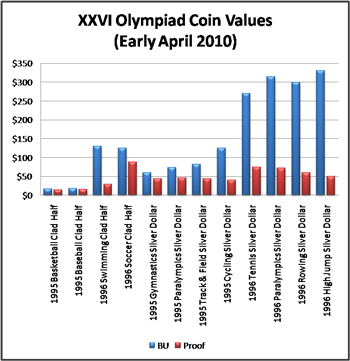At the show this weekend, we had a gentleman looking for a XXVI Olympiad Tennis Commemorative Dollar. When asked which he wanted, BU or Proof, he was not sure and wanted to know the difference.
First, let’s talk about the difference between BU and Proof. BU is short for uncirculated (brilliant uncirculated) coins.
One might ask, well, commemoratives are not released to the public so why aren’t they all uncirculated?
That’s true. Even though commemoratives are legal tender, they do not get circulated. Their value is much higher for their collectability rather than their worth as spendable coinage.
But, the difference in uncirculated and proof – at least in the 1995/1996 timeframes when these coins were minted – shows in how the mint struck the coins. Uncirculated coins in that timeframe were minted and treated like the coins for circulation, but they were packaged in protective coin holders before being sold. Thus, they were “uncirculated” meaning they weren’t bagged with other coins with the associated nicks and scrapes from the coins rubbing together. Plus, they did not get the fingerprints and handling that circulated coins would have.
On the other hand, the US Mint explains, “United States proof coins are produced from carefully selected planchets, or coin blanks, that have been burnished to a high luster. The polished blanks, which are carefully handled to minimize scratches and abrasions, are struck on specially adapted coining presses. Each coin is struck at least twice to bring forth the most minute detail with remarkable clarity.”
Thus, the proof coins are “prettier” in that they have a mirror-like shine for the background and a very detailed design. Though, the uncirculated coins are nice, they don’t have the clarity of the proof.
OK, that helps, but why is the Tennis BU – which you say is less attractive – much more expensive than the proof Tennis coin?
The short answer is supply and demand. Let’s look at the population charts for the XXVI Olympiad commemorative coins. The population numbers are to the nearest 500.
Now, let’s look at the coins’ values as of early April. These values are no longer current but are sufficient for illustration purposes.
Isn’t it interesting that the high bars in the population chart are almost always the low bars in the values chart? That’s called supply and demand. When supply is sufficient to meet (and/or exceed) all of the demand, then the values are lower.
If the mintages are lower such that supply cannot satisfy all of the demand, then the values per coin go up. And, since the Mint does not make these coins any more, the supply does not increase to meet the demand.
But, you will also notice that some of the large population variations between the Unc and Proof coins do not equate to such a large difference in their values (for example, 1995 Baseball Half and 1995 Gymnastics Dollar).
In some cases the collectors’ interests impact the market value. If people are not looking for those specific coins, the demand does not exceed the supply and the market rate does not go up as dramatically.
Of course, this multivariate equation includes the metal content of the coins as well. Sometimes the metal impacts more than others such as when silver climbs.
To many, they’re happy just to collect, but if you are a collector also looking at longer term value think about their beauty, their grade, the way they’re made, their population numbers and their metal content.
But, most of all, have fun!

